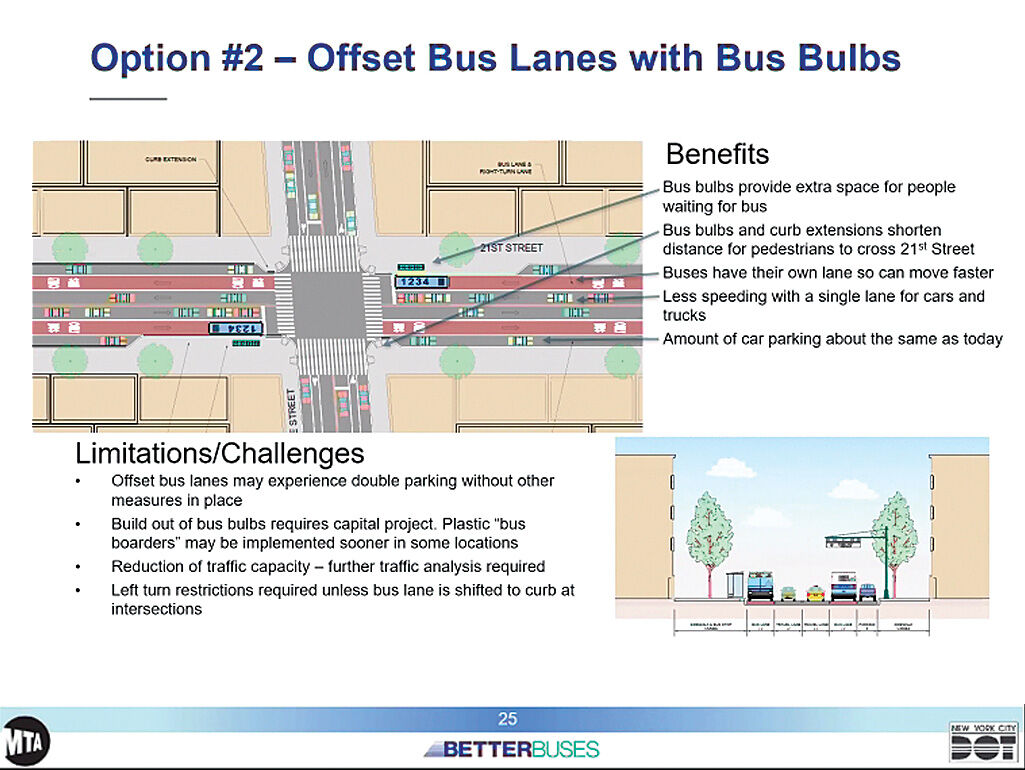
The city’s Jan. 12 presentation on plans to put bus lanes on a two-mile stretch of 21st Street in Astoria appeared to change few if any minds.
Residents who have said in the past that the Department of Transportation is going too far for traffic and pedestrian safety upgrades still thought so. Also unmoved were those who think the DOT’s preferred option does not go far enough.
More than 100 people participated in the virtual meeting at one point or another.
And the DOT still is presenting a plan to remove a lane of traffic in each direction between Hoyt Avenue North and Queens Plaza North as its preferred of three options.
The stretch runs from the approaches to the RFK/Triborough Bridge in the north and the Ed Koch-Queensborough Bridge to the south.
The roadway has been tagged as a bus priority corridor by the Metropolitan Transportation Authority, as it is served by the Q66, Q69 and Q100 routes. It also is a Vision Zero priority corridor based on the number of fatal and serious accidents in recent years.
Christopher Hrones, director of strategic transit initiatives for the DOT, said the city prefers bus lanes that run between cars parked at the curb and what would be the lone remaining travel lane in each direction. Concrete extensions, known as bus bulbs, at intersection bus stops would shorten the distance that pedestrians would spend in the street while crossing.
Hrones said those changes would have minimal impact on existing parking, as they would mostly keep buses away from the curb.
He acknowledged that there initially could be traffic backups; and that left turns in many places would be eliminated. Several bus stops would be eliminated in order to speed up each individual bus’ trips. Double-parking by delivery trucks would have to be addressed.
Hrones said that any backups wold eventually thin out over time as people adjusted their behavior, either switching from cars to buses, taking different routes or driving at different times of day.
Many residents were not convinced.
“You can’t have one [traffic] lane on the 21st Street corridor,” said resident Margaret Cooper.
“I have to drive. I can’t take a bike,” said Gloria Maloney. “I know there are people who want everyone to use bicycles, but that is not feasible.”
Maloney also said the elimination of bus stops, particularly near housing projects with a high concentration of senior citizens, would pose a hardship for many.




10 comments:
They hold these "Meetings" so they can say they did when the "Project" fails. They're trying to give the community the impression that they have some say/input in how badly they're going to be fucked by the impresarios at DOT/MTA.
Remember when they had the listening sessions before the Woodhaven Boulevard debacle? They broke attendees into smaller groups of no more than 5-7, ostensibly, so they could explain it better to a smaller group. Their real intent was to not have one larger group sharing information with each other. MTA/DOT is totally giving it to this city up the ass in the name of bike and buses...
Woodhaven Boulevard by the way is still a clusterfuck....
Seems like the communist car zealots are getting organized.
If everyone on those busses drove their own car, now that would solve traffic!
How can public housing residents afford cars?
@"Seems like the communist car zealots are getting organized."
Probably just stooges funded by Elon Musk.
Prove me wrong ...
Seems like the communist car zealots are getting organized.
Says the true communist clone from TA, the bike gulag's union chief.
How can public housing residents afford cars?
Now why ask why?
How can Nancy Pelosi have $120 Million from trading?
How can Bill "FuckHim" Gates have billions of $$$?
How can Jeff "Monopoly Ruin Small Businesses" Bezos have $200 billion?
How can Anthony Fauci have $10.4 Million? Plus Patents?
Ask the right questions pal, leave the common folk alone.
@“ Says the true communist clone from TA,”
Hey, Trump Turd, what’s TA? Is it Truck Stops of America? Those places have gone downhill over the past few years.
No, these aren't common folk, they are sucking the same public teet as the ruling class.
NYCHA Public Housing residents can afford cars because their rent is very low, it's adjusted to their income. Unlike any other NYC tenant, they only pay less than 30% of their monthly income when the rest of us are paying over 80% of our income to keep a roof over our heads. Plus they get free gas and most NYCHA were giving free electric, but that might have changed.
AND most tenants pass the apartments on to family members or illegally sublet it and go live in another state.
NYCHA was supposed to be temporary while the tenants saved up enough to buy a home or move to a better neighborhood. Not anymore. Unless they're shot up or a family member is killed in their project, they just don't move.
Post a Comment